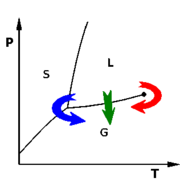Freeze drying
 | Freeze drying (blue arrow) brings the system around the triple point, avoiding the direct liquid-gas transition seen in ordinary drying (green arrow). |
Freeze drying (also known as Lyophilization) is a dehydration process typically used to preserve a perishable material, or to make the material more convenient for transport. Freeze drying works by freezing the material and then reducing the surrounding pressure to allow the frozen water in the material to sublimate directly from the solid phase to gas. Sublimation is the action that gradually causes shrinkage of unused ice cubes in frost-free freezers and the disappearance of winter snow without thawing. The application of high vacuum in freeze drying sublimates ice much more quickly, making it useful as a deliberate drying process. A cold condenser chamber and/or condenser plates provide a surface(s) for the vapour to re-solidify on. These surfaces must be colder than the temperature of the surface of the material being dried, or the vapour will not migrate to the collector. Temperatures for this ice collection are typically below -50 °C. The greatly reduced water content that results inhibits the action of microorganisms and enzymes that would normally spoil or degrade the substance.
If a freeze-dried substance is sealed to prevent the reabsorption of moisture, the substance may be stored at room temperature without refrigeration, and be protected against spoilage for many years. Freeze drying tends to damage the tissue being dehydrated less than other dehydration methods, which involve higher temperatures. Freeze drying doesn't usually cause shrinkage or toughening of the material being dried, and flavours/smells also remain virtually unchanged.
Also, liquid solutions that are freeze-dried can be rehydrated (reconstituted) much more quickly and easily because it leaves microscopic pores in the resulting powder. The pores are created by the ice crystals that sublimate, leaving gaps or pores in its place. This is especially important when it comes to pharmaceutical uses. Lyophilization also increases the shelf life of drugs for many years.
The process has been popularized in the form of freeze dried ice cream and as an example of astronaut food. It is also popular and convenient for hikers because the reduced weight allows them to carry more food and reconstitute it with available water. Freeze drying is used in the manufacture of instant coffee as well as some pharmaceuticals.
In high altitude environments, the low temperatures and pressures can sometimes produce natural mummies by a process of freeze-drying.
In chemical synthesis, products are often lyophilized to make them more manageable or more easy to dissolve in water for subsequent use.
External links
- http://home.howstuffworks.com/freeze-drying.htm/printable
- http://inventors.about.com/library/inventors/blfrdrfood.htm
- http://www.fda.gov/ora/inspect_ref/igs/lyophi.html
- http://www.rpi.edu/dept/chem-eng/Biotech-Environ/LYO/index.html
